High-yielding mid-late cabbage hybrid Menza f1
Menza F1 cabbage is grown by both large industrial enterprises and gardeners in different regions of Russia, Ukraine, and Moldova. Mensa F1 has been cultivated for more than half a century. During this time, it gained wide popularity due to its advantages and ease of care.
Description of cabbage hybrid Menza F1
A high-yielding mid-late hybrid has long been known to gardeners and is considered a classic. White cabbage is a plant of the Cruciferous family; the leaves are eaten.
Origin
Mensa F1 (from the word "mensa" - "table") - a hybrid bred Dutch breeders in the middle of the 20th century In 1960 it was entered into the State Register. The USSR State Commission for Variety Testing recommended the hybrid for cultivation throughout Russia. Scientists are working on Menza as a promising source material, creating hybrids for the Far Eastern region.
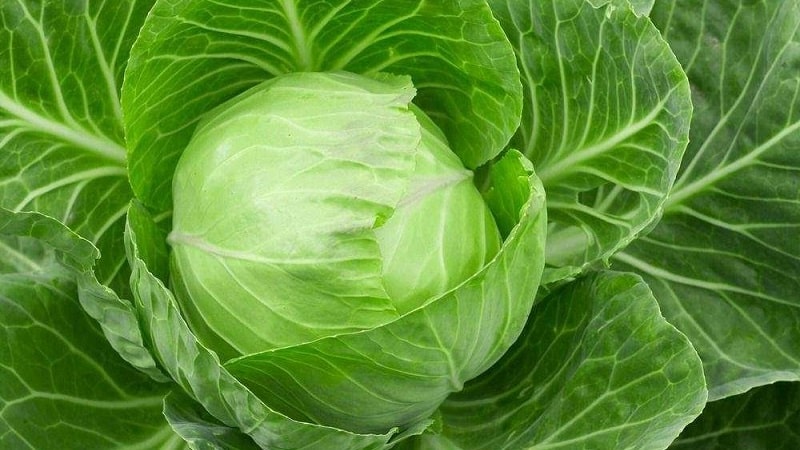
Chemical composition and beneficial properties
Cabbage contains all the necessary substances that are beneficial for the human body.
100 g of product contains:
- carbohydrates (glucose, fructose, sucrose) – up to 7%;
- vitamins:
- PP – 0.8 mg;
- beta-carotene – 0.02 mg;
- A (RE) – 4 mcg;
- B1 (thiamine) – 0.03 mg;
- B2 (riboflavin) – 0.04 mg;
- B5 (pantothenic acid) – 0.2 mg;
- B6 (pyridoxine) – 0.1 mg;
- B9 (folic acid) – 11 mcg;
- C – 46 mg;
- E (TE) – 0.1 mg;
- PP (niacin equivalent) – 0.8 mg;
- N (biotic) – 0.1 mcg;
- K (phylloquinone) – 77 mcg;
- choline – 10.8 mg.
- macroelements:
- calcium – 47 mg;
- magnesium – 15 mg;
- sodium – 12 mg;
- potassium – 300 mg;
- phosphorus – 32 mg;
- chlorine – 38 mg;
- sulfur – 36 mg.
- microelements:
- iron – 0.7 mg;
- zinc – 0.4 mg;
- iodine – 3 mcg;
- copper – 74 mcg;
- manganese – 0.16 mg;
- selenium – 0.4 mcg;
- fluoride – 11 mcg;
- molybdenum – 9 mcg;
- boron – 201 mcg;
- cobalt – 3 mcg;
- aluminum – 571 mcg;
- nickel – 16 mcg.
- 16 free amino acids – 0.3 g.
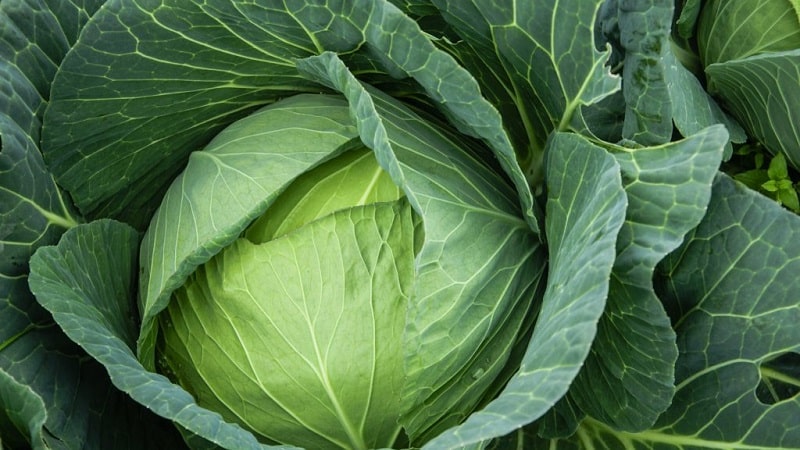
In folk medicine cabbage is valued for its antiseptic, anti-inflammatory, healing properties. Improves the functioning of the digestive, cardiovascular and endocrine systems. Helps with:
- headache;
- insomnia;
- stomach and duodenal ulcers;
- diseases of the liver, joints;
- wounds, ulcers and burns;
- reduced immunity;
- lack of vitamins;
- constipation and hemorrhoids;
- jaundice;
- overweight;
- bronchitis etc.
For enterocolitis, pancreatitis, tendency to increased gas formation, eating cabbage is not recommended.
Features of application
Various dishes are prepared from Mensa F1 leaves. Due to the lack of bitterness, they are eaten raw. This hybrid suitable for pickling and pickling, sales and long-distance transportation.
Ripening time and yield
Cabbage has a medium-late ripening period, with a growing season (from the moment the first shoots appear) of 105-115 days. By mid-August - September it is finally formed and matures..
Productivity is very high. Experienced gardeners harvest from 80 to 90 tons of high-quality cabbage from 1 hectare of plantings.
Resistance to disease and cold
The hybrid has good immunity and is resistant to powdery mildew, bacteriosis, mosaic, but susceptible to clubroot. Tolerates frosts down to -2°C, making it suitable for growing in various climatic conditions, even in Siberia and the Urals.
Description of appearance and taste
The head of cabbage has a dense structure, flat-round shape, average weight 4-5 kg. The outside is light green and the inside is white. Cabbage leaf has:
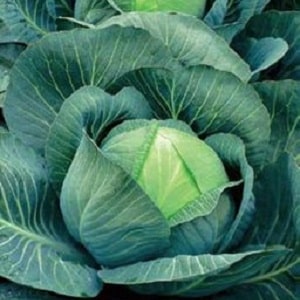 average size – up to 40 cm in diameter;
average size – up to 40 cm in diameter;- wavy edge;
- gray-green color;
- waxy coating providing good shelf life;
- crispy, juicy texture;
- sweet taste without bitterness.
The vegetable has a small external stalk; the heads of cabbage do not crack. The taste, as well as the product quality, is excellent..
Advantages and disadvantages of the Menza F1 hybrid
Hybrid is famous:
- wonderful taste;
- juiciness;
- high sugar content (7%);
- excellent presentation, thanks to which it is quickly sold out on the market;
- resistance to head cracking, drought and temperature changes;
- long storage not only in the cellar, but also on a leg in the garden;
- universal use: cabbage is fermented and consumed fresh;
- sizes (up to 9 kg - the weight of one head of cabbage).
Disadvantages of Menza F1:
- Not all housewives find it convenient to process a large head of cabbage.
- Reduced immunity to fungal disease - clubroot.
Difference from other varieties and hybrids
Has high resistance to cracking and lacks bitterness in taste. The hybrid tolerates heat and lack of moisture more easily than many other varieties.
Attention! A striking distinctive feature of Menza is its short leg (stump), thanks to which hilling can be done 1 time instead of the required 2. It also prevents the head of cabbage from falling to one side, which ensures stability on the root.
Features of planting and growing
To get a good harvest, it is important to follow agricultural practices.
Preparing for landing
For getting strong seedlings prepare the soil in advance, preferably in the autumn, consisting of equal parts of leaf soil and humus, add 1 tbsp. l. ash per 1 kg of mixture. The soil is disinfected - frozen, calcined or steamed.
Seed preparation
Planting material is purchased in specialized stores, because when collected from hybrids, the properties of the variety are not preserved.
Important! You cannot treat the seeds yourself with growth stimulants or disinfect them with chemicals. The manufacturer has already done this. It is also undesirable to soak, otherwise the protective layer will be washed off.
Preparing seedlings
To get healthy and strong seedlings, It is recommended to grow it in wooden boxes or plastic containers. In the first ten days of March, seeds are sown in them to a depth of 1 cm, maintaining a distance of 5 cm from each other. The soil mixture is well moistened. Leave the container indoors at an air temperature of at least +24°C.
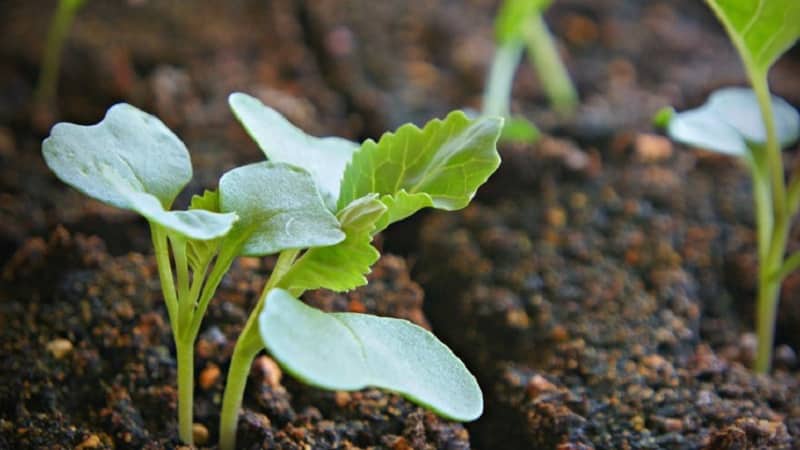
Shoots appear after 7 days, the room temperature is reduced to +17°C, and the seedlings are placed on a windowsill with good lighting. In cloudy weather, fluorescent lamps are used for illumination, and the soil is kept moist.
To develop the root system and provide nutrition 14 days after emergence, the seedlings are planted in separate containers measuring 5x5 cm, treated with a weak solution of potassium permanganate or copper sulfate.
10 days before disembarkation in open ground they begin to take the seedlings outside, covering with gauze from direct sunlight. Each time, the time spent in the fresh air is increased, bringing it to full daylight hours.
How to plant without seedlings
Procedure:
- The soil is fertilized, treated to remove pathogens, cleared of weeds and thoroughly saturated with moisture.
- Mid-late cabbage is sown in the first half of May.You will need much more seeds for sowing than with the seedling method, because some of the sprouts will disappear, some will be thinned out. Up to 3 seeds are placed in a hole at a depth of 2-3 cm, following a 50x60 cm pattern.
- The crops are sprinkled with slightly moistened peat mixed with humus; they are not watered due to the risk of washing out the seeds.
- After this, they are covered with material to create greenhouse conditions.
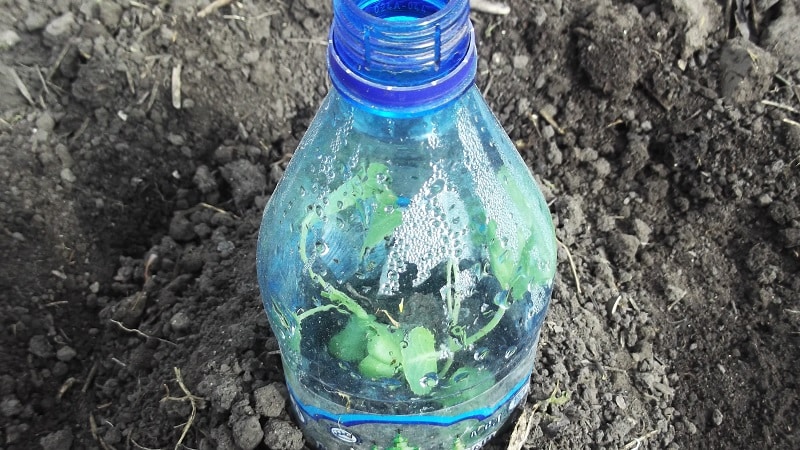
Soil requirements
For planting, select soil with a medium loamy composition and a pH of 6.5-7.5. Cabbage loves light, but the scorching rays of the sun still have an adverse effect on it. For this reason, tall crops such as corn or sunflower are planted nearby. The soil is prepared in the fall: the garden is dug up and organic fertilizers are applied. In spring, the area is dug up again and fertilized: per 1 m² soil add 200 g of plant ash, 1 tbsp. l. nitrophoska and 1 tsp. urea.
Predecessors
Cabbage greatly depletes the soil as it grows., taking away nutrients, so grow in the same place next year it is forbidden. There is another reason: overwintered larvae and pathogenic bacteria may be in the soil.
A good harvest will ensure compliance with crop rotation: The place where the vegetable is planted is changed annually. Cabbage grows better after rye, legumes, early ripening potatoes, onions and cucumbers. They slightly deplete the fertile layer of the soil and have a different diet, and even disinfect onions and garlic.
It is not recommended to plant cabbage in places where they grew last season. other cruciferous vegetables (turnips, radishes, lettuce, radishes), zucchini, pumpkin and carrots. After these crops, the soil becomes depleted and can become contaminated with larvae and bacteria.
Dates, scheme and rules of planting
Seedlings are considered ready when there are 4-5 leaves. This occurs approximately 45-55 days after germination. It is transplanted into soil heated to at least +10°C (in May). Planting pattern – 50x60 cm.
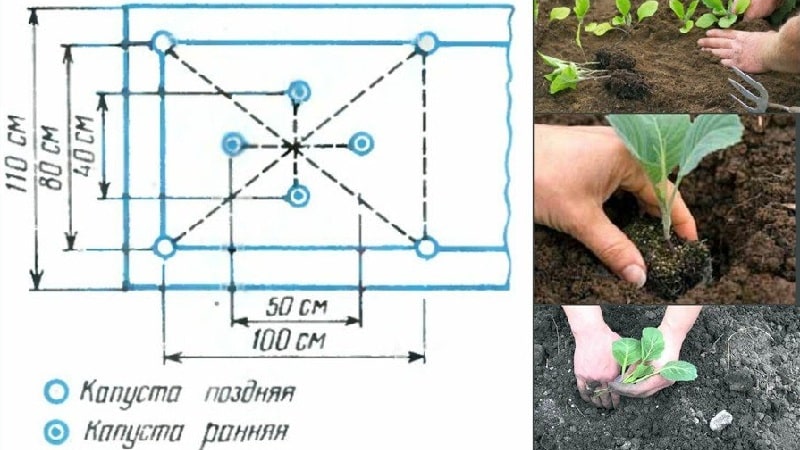
Planting density and depth
The roots are deepened by 5 cm, maintaining a distance between seedlings of 50 cm, between rows - 60 cm.
Features of cultivation
The hybrid is grown both in open ground and in greenhouse conditions.
Mensa F1 is easy to care for. It is carried out according to the standard scheme, and since cabbage is moisture-loving, watering plays the main role.
Watering mode
After transplantation, the seedlings are watered every day. When the bush begins to grow, watering is carried out once every 3-4 days (3 liters per bush), preferably in the morning or evening, because during the day the sun is at its zenith. This is fraught with rapid evaporation of moisture from the soil surface. Watering is stopped 2-3 weeks before harvest. This will protect against cracking and increase shelf life, which is important during storage.
Loosening and hilling
Loosening is best done after irrigating the soil. (3-6 times per season). Due to watering, the earth is compressed, which makes it difficult for air to access the root system. Loosening will not only enrich the soil with oxygen, but at the same time remove weeds and pests that have settled at the cabbage root.
Thanks to the very small outer stump (leg) It is enough to carry out hilling once during the formation of heads of cabbage.
Top dressing
To obtain a high-quality harvest, the crop is fertilized 3 times:
- The first time this is done 3 weeks after picking the seedlings, pouring at least 1/2 liter of the prepared solution under each sprout (1 kg of mullein is poured into 10 liters of water).
- The second feeding is carried out 2 weeks after the first with the same solution, but its volume is increased to 1.5 liters for each bush.
- For the third time, fertilize with superphosphate (40 mg per 10 liters of water) and potassium nitrate (20 mg per 10 liters of water) during the period of setting heads, pouring 2 liters of the mixture under each plant.
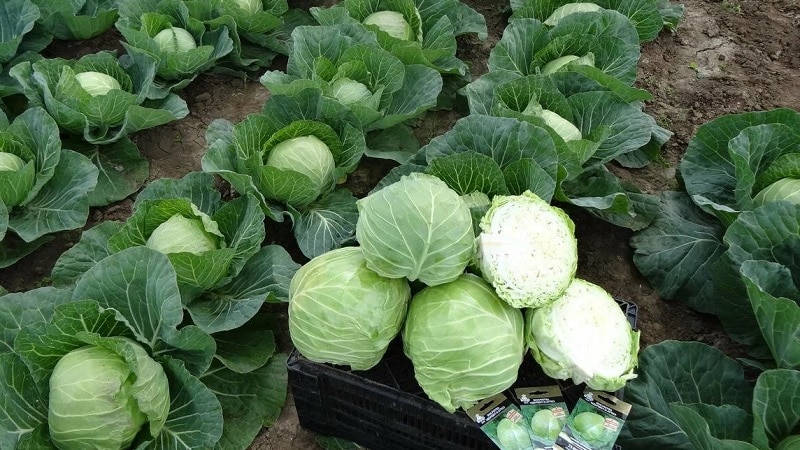
Measures to increase yield
It is important to follow standard agrotechnical procedures: watering, fertilizing, loosening, hilling, treating against diseases and pests.
Disease and pest control
The hybrid has a well-developed immune system and is resistant to powdery mildew, bacteriosis, and mosaic. But has no protection against clubroot, which damages the root system. It can be recognized by its symptoms:
- leaves wither;
- heads of cabbage are not tied;
- there are lumps and growths on the roots.
To prevent this disease Before transplanting, the soil is treated with a solution of potassium permanganate (2 mg per 10 liters of water) or colloidal sulfur (5 g per 1 m² of land).
The greatest dangers to this hybrid are aphids and cabbage flea beetles. When aphids are infested (the peak occurs in August), the following symptoms are observed::
- slowing down plant growth;
- pinkish tint of leaves;
- curling and withering.
Aphids are located on the lower part of the leaves. To combat the pest, plants are sprayed with insecticides.
Using colloidal salt you can get rid of fleas. Signs of damage:
- holes in the leaves that adults chew;
- death of young cabbage;
- larvae eating roots;
- bad harvest.
Difficulties in growing
The hybrid is being cultivated by the second generation. It gained such popularity not only due to its excellent qualities, but also due to its ease of cultivation. Does not require additional care, does not pose any difficulties for growing.
Harvest and storage
The ripe crop is cut with a sharp knife in August - September in clear weather., leaving 3-5 cm of the fruit stem.The cut cabbage is placed in a cool, dry room for several days so that the cuts on the stalks dry out. Heads of cabbage harvested during rain are also dried before storing.
Storage features and keeping quality of the Menza F1 hybrid
For storage choose undamaged, dense vegetables. It is important that there is no moisture on the surface. This will eliminate the risk of developing a fungal infection. Thanks to its good shelf life, the harvest harvested in the fall is stored until March. At the same time, taste and presentation are not lost.
Attention! Fresh cabbage is stored at a temperature of 0°C and air humidity of 80%.
Reviews from experienced gardeners
In reviews of Menza F1 cabbage, gardeners note high taste, unpretentiousness and good keeping quality.
Nadezhda V., Omsk: “I only grow this cabbage. It is large and does not crack. I store it underground for up to six months. Very good taste. I treat pests in advance for prevention. Cabbage can also be grown in a greenhouse.”
Mitsa Ivan, Kyiv: “I’ve been growing Menza for pickling for a long time. I really like its crispy leaves. I store another part of the harvest in a pit. The heads of cabbage lie until March, maintaining their original appearance. I don't do anything special to take care of it. Everything is as usual: watering, hilling, feeding. I'm happy with the harvest".
Conclusion
The cabbage hybrid Menza F1 is productive, hardy and unpretentious for growing in various climatic conditions. With little effort and time, following the basics of cultivation and the recommendations described in the article, you can get a high yield of tasty, crispy cabbage.